For a long time I used to get up early on the day of the Annual Anti-Gentrification Street Festival. I’d join the crew that set up traffic barricades on Claremont, Broadway and Riverside and lug tables from International House—the dorm for foreign students on Claremont—down to Tiemann Place. I’ve tended to flake off lately though. My nephew Jamie and his gen seemed to have taken on the job after my brother Tom died—retiring elders like me. Yet this September I’d been more involved in prep since we’d arranged with our Councilman’s office and the DOT to schedule the “unveiling” of an official sign co-naming Tiemann Place “Tom DeMott Way” on Festival day.
Thanks to a prompt I could not refuse from an Irishwoman, Anah Klate, on September 16th I was up and out on the street by mid-morn (as grey went blue). Anah, who’d been a stranger to me, turned out to be a small, feisty lady in blue jean cut-offs who could a pull a gamin out of her back pocket as she teased her volunteers to T.C.B. Ms. Klate came to the block about twenty years ago. I’m not sure when she started herding tomcats on Festival mornings, but her air of expectancy was obviously earned. Everyone treated her with respect. It wasn’t all about the Benjamins. I’m not even sure her crew knew she’d crowd-sourced funding for the event—raising 2K needed to pay for bouncy house, dunk tank, portable basketball hoop, etc. (Anah started using GoFundMe to cover costs in 2022.)[1]
After I did my tiny bit, I settled in for a stretch at the top of Tiemann next to Tom’s old building where Gus (from the Rodriguez clan) was reading his paper in a bower-on-the-street. He’d brought out a table, two chairs and a bunch of plants from his crib. His nook took me back to my night before, where I’d partied with old friends, who were celebrating their daughter’s 30th birthday on the roof of their building, which they began turning into a rain forest on the Upper West Side decades ago. (A green thumbs up to Gus R. and Myers’ from my gone Tom-and-Mom who would’ve reveled in their urban gardens.)
Gus’s son came by looking for his son and that was a sign the party was on. The kids would race up and down the street until the night began to fade them out. I’m sure the water in the dunk tank felt cool-fresh in the heat of the day. B-ballers of all ages hit the street and the bouncy castle vibrated all afternoon. (Block power!—Those kids could’ve juiced the nation’s energy supply.)
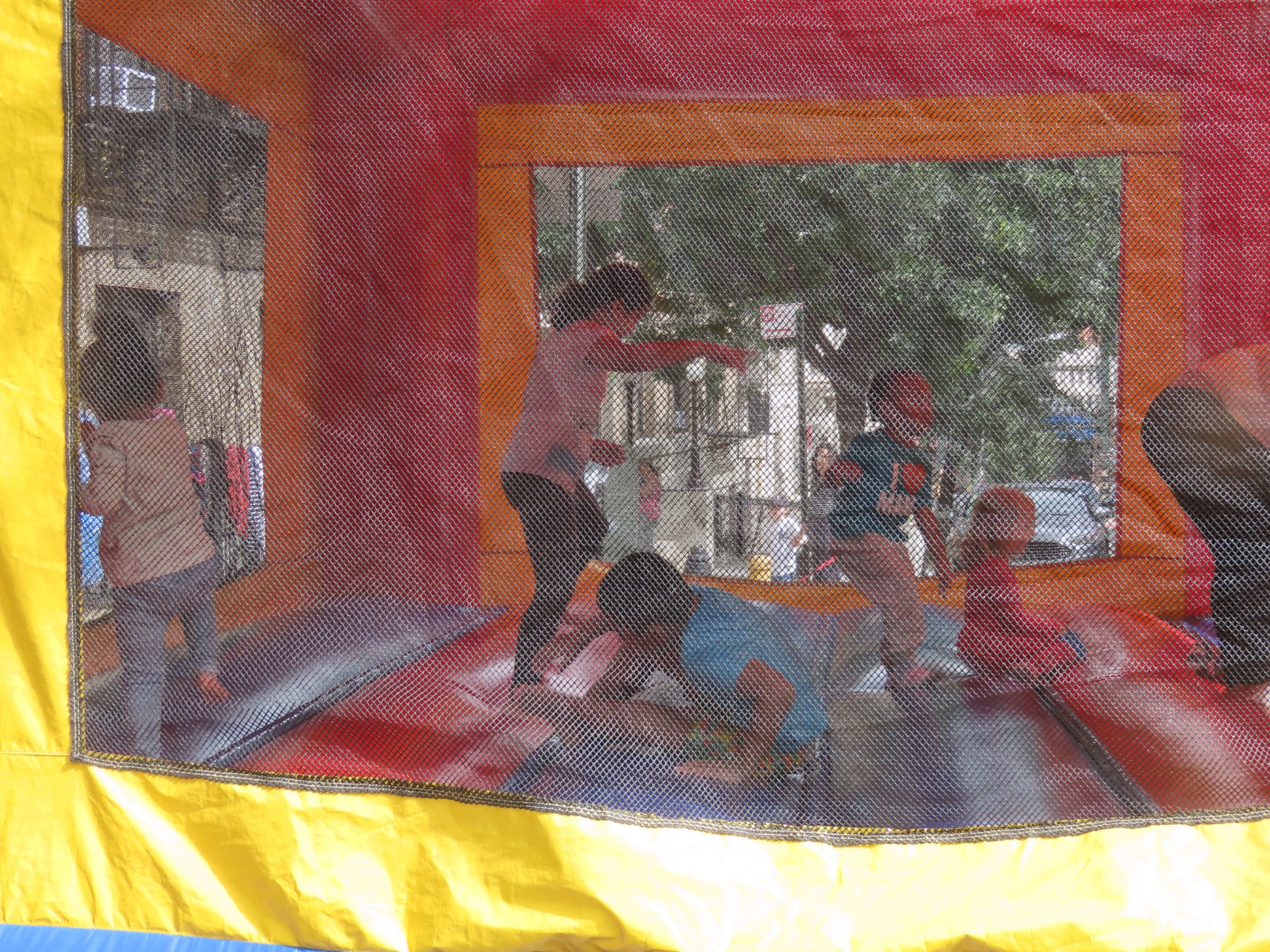
The castle was near the DJs’ rig and at one point the contraption seemed to be dancing to old school Atomic Dog meets Kraftwerk electro-beat. Tear the roof off the sucker? I could feel the Castle rock from up the street, though my attention was diverted by this girl who gamboled by, mutt-in-arms, trailed by a little boy with curls and face-paint…

Adults were watching, though nobody was telling kids (or pets) what to do next. It seemed apt when my wife and I got a chance to host Rosa (con su familia)—the Ecuadoran abuela who mothered (without smothering) our son when he was two or three years old. It’s a lovely story so…
Back in the mid-00s my wife tried to make a go of a $10 clothing store around 140th and Broadway—not a prime spot given that dealers gathered in front of her window, blocking views of her wares. Rosa—who knew us from nada before Mbayang opened up uptown—noticed the new proprietor often seemed harried. As a calmative, she began picking up toddler Ben from “BK Boutique” each day before noon, taking him around the corner to her apartment where she’d make him lunch—Rosa is a good cooker (per Mbayang)—while he noodled on the parlor-piano, played with the cats, and explored Rosa’s (thirty-something) sons’ forgotten toys. In the evenings, Rosa would go back to the store and make sure Mbayang was safe. My wife had reason to feel fearful because she’d snubbed the local chamber of illicit commerce who unleashed bloody-minded Santeros to scare her. Nobody trusted cops to protect anyone in that neighborhood. (Mbayang once dealt with a lieutenant who was wary of everyone in his command.)
Our police precinct isn’t as dicey. Cops were a low-key presence at this year’s féte. There were a couple of p.c. outliers on the block, though, who felt a need to police other people’s opinions. A longtime comrade-turned-frenemy of my late brother gave my son a verbal punch after he brought up the heroism of Ukrainians on the Maidan in the Winter 2013-14: “So you’re pro-war.” Slava Ukraini! (I missed my son’s actual comeback but he wasn’t too intimidated to say which side he was on.) There was another odd moment of censoriousness that I haven’t really parsed. I began in incomprehension. An old-timer came up to me complaining that a DJ was about to segue from reggaeton to a National Anthem. I guessed the kvetcher was objecting to “The Star-Spangled Banner.” While I might’ve gone for the implicit linkage of Tom DeMott Way with The American Way, Tom’s wife Maria (who’s never stood for the anthem) would’ve been put off by amber waves of grain and, on the real side, Tom would’ve been ambivalent too. But this was all moot since I had the wrong song. One of our three DJs apparently mentioned he planned to play the Indian national anthem. I didn’t delve further so I never found out if this was some Modi-esque gesture or a Caribbean-based lark. But it vexed the elder—a Muslim-symp from Iraq who’s less than pious yet still felt compelled to act as the Ummah’s sentry. Suddenly the block was implicated not just in Russia’s imperial war, but in Indian partition. (What would Gandhi do?) The Indian anthem didn’t make it into the mix, but, looking back in puzzlement, I’m glad everyone I knew at the party welcomed the Indian wife of an old friend who came by with her husband, though they had to break out before the unveiling to make a Rosh Hashanah dinner.
My friend’s wife’s sojourn on the block—they came to last year’s party too—brought to mind one of my favorite figures in My Weil—the comic novel by Lars Iyer I rushed through during the run-up to the Festival. Iyer puts a subcontinental twist on his deft meld of Lucky Jim and 24-Hour Party People—including a posh Indian beauty in his fictional crew of rad Brit grad students who are failing to do PhD’s under the aegis of the “Disaster Studies” Department at a beat-down Uni in Manchester. Gita rolls with her mates’ punky mockery of “Prof. Bullocks,” “art-wank,” Business Studies students, to-the-tenure-born types at a tonier school, yet she also repeatedly busts their high trifling. She serves as a grounded, desirous contra to her cohorts’ other exemplar—the student invoked in the novel’s title who tries to walk like Simone Weil (“nun-shoes” and all). I was tickled to find Gita facing off with a character acting Weily (even if the would-be saint wasn’t up to the real Rosa) at the very moment when my brother’s name was going up on a sign a half-block away from the Riverside Drive plaque memorializing Weil’s season in exile in NYC.
My Weil leans on its Mancunian black sun setting. Iyer’s anti-heroes still get thrills from sounds of their city’s greatest depressives—Joy Division, Happy Mondays, Morrissey, New Order. There’s wilding in the streets and faux-lumpen scuffling about in overgrown commons at the city’s edge. Iyer’s students of low life seem to be on to something when they connect shattered urban street people with changing climes. A walker in my city now can’t help but become a Master of Disaster Studies. (I seem to run into someone broken every time I do my nightly constitutional on the UWS.) “There is a natural alliance,” the real Weil wrote, “between truth and affliction, because both of them are mute supplicants, eternally condemned to stand speechless in our presence.” The screamers I pass by (more frequently than ever?) aren’t mute, but they may as well be since their shouts in the street are overwritten by blankest generation hopelessness. My Weil’s wiseasses do no-futurism with a comic vengeance. Yet author Iyer, with help from his Gita, isn’t afraid to take the piss out of their lumpen-identification (without dumping on their compassion). My Weil sallies past fashionable leftism of psychosis. Near the end of the novel, Iyer plays with the history of cinema (the beach scene in Malick’s Tree of Life) and pop lore (raves at The Hacienda) to conger up restorative places: “Where we’ve retired the words eschatology and Gnosticism. Where the word apocalypse never passes our lips.” My instinct says Iyer would’ve been at home in our hood last Saturday. An affirmation in one of his scripts for a peace beyond negative dialectics—”What we Want (with a capital W):…Not to have lived for nothing. Not just to have fallen.”—seems on point when I think of my late brother’s life and gaze at this festive photo.
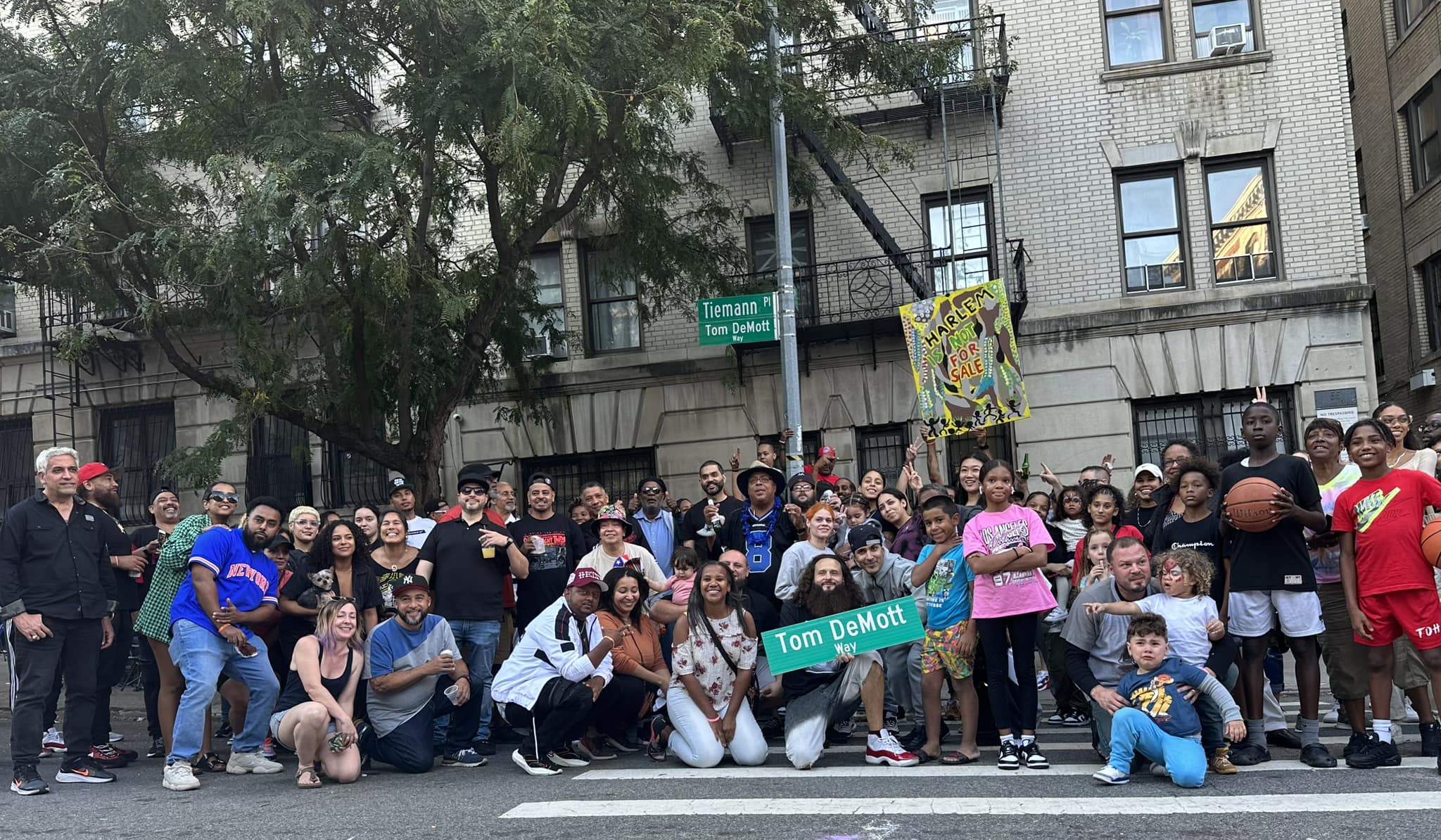
I heard an echo from My Weil’s muse as I pored over more post-Festival pics of our public happiness. (Maybe I was under the influence of one grinning hombre who was wearing a t-shirt that read BENDICIÓN.) The saint of outsiders once recalled an instance when she felt Jesus’s presence (as she tried to soothe a migraine by reading George Herbert’s sonnet “Love” (III).): “…in this sudden hold Christ had on me, neither my imagination nor my senses played any part; I simply felt, across the pain, the presence of love, similar to that which one can read on the smile of a loved face…”
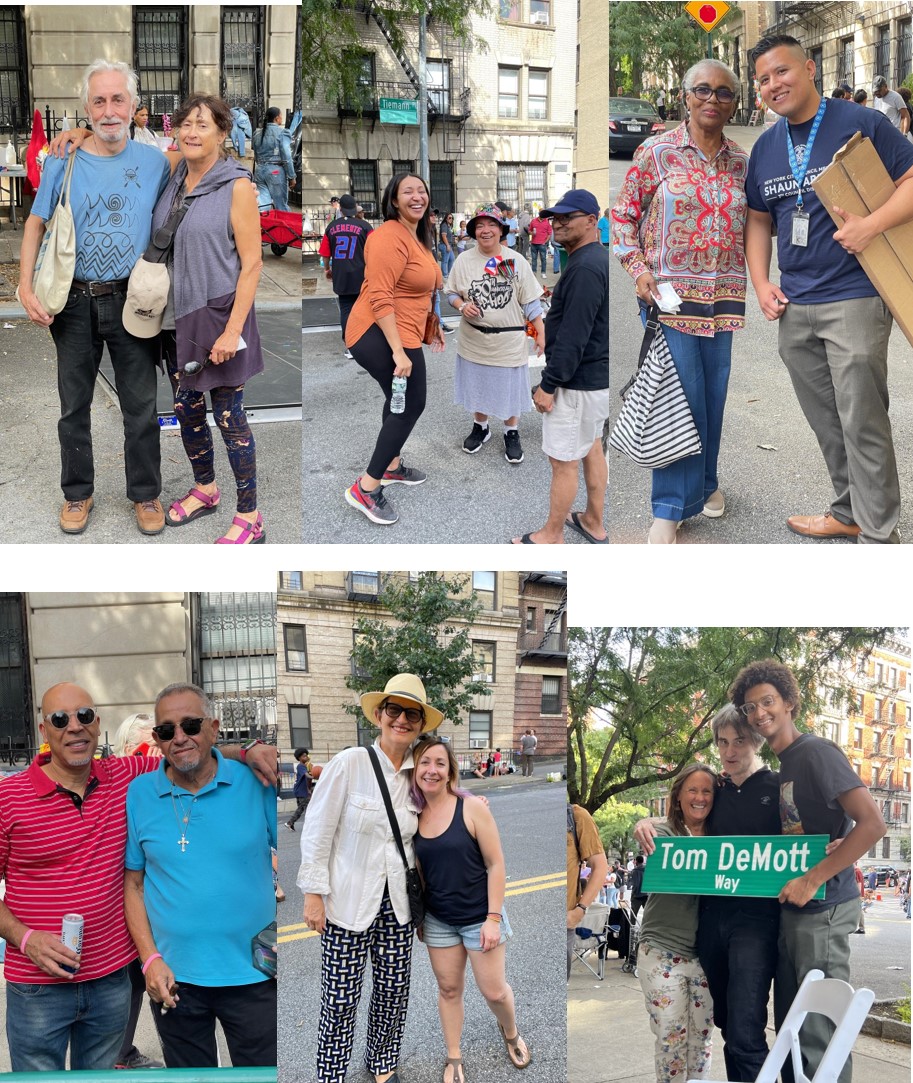
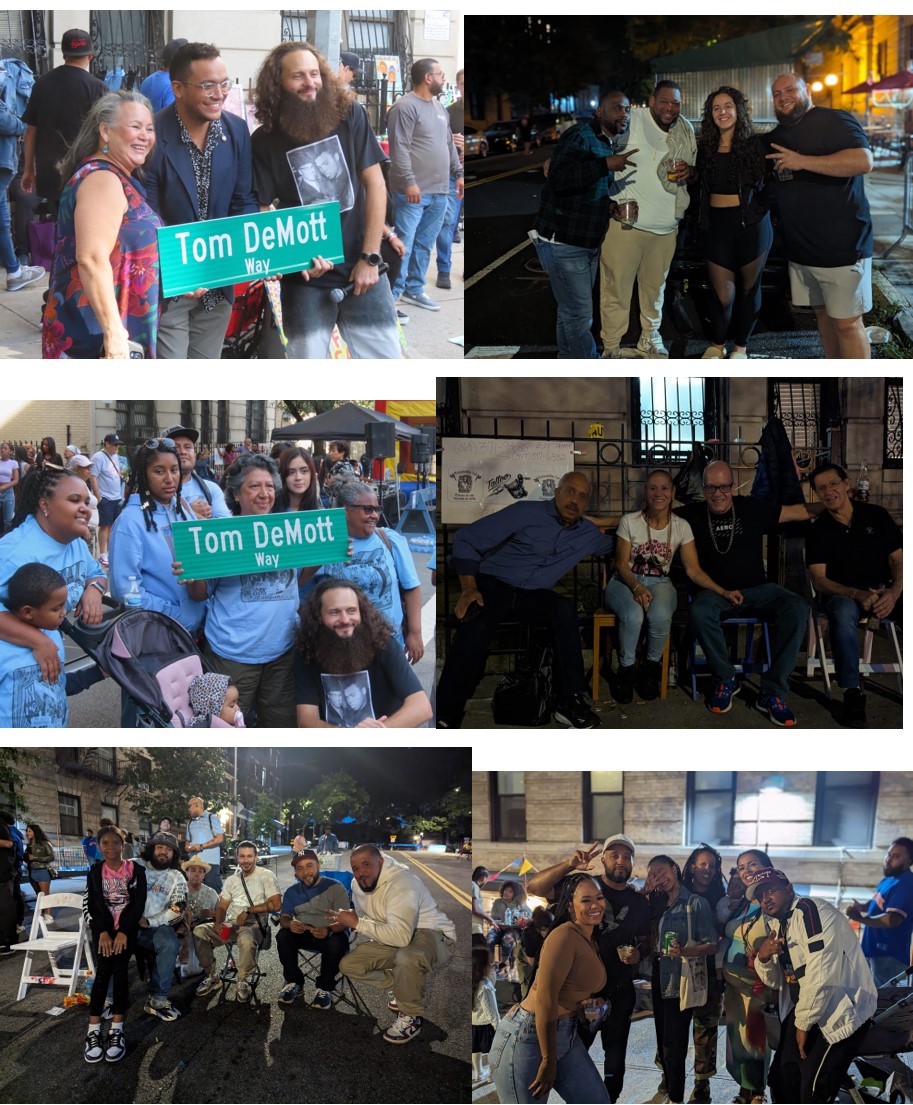
The shots in the dark really need to be larger so here’s a couple mo’ bigger…
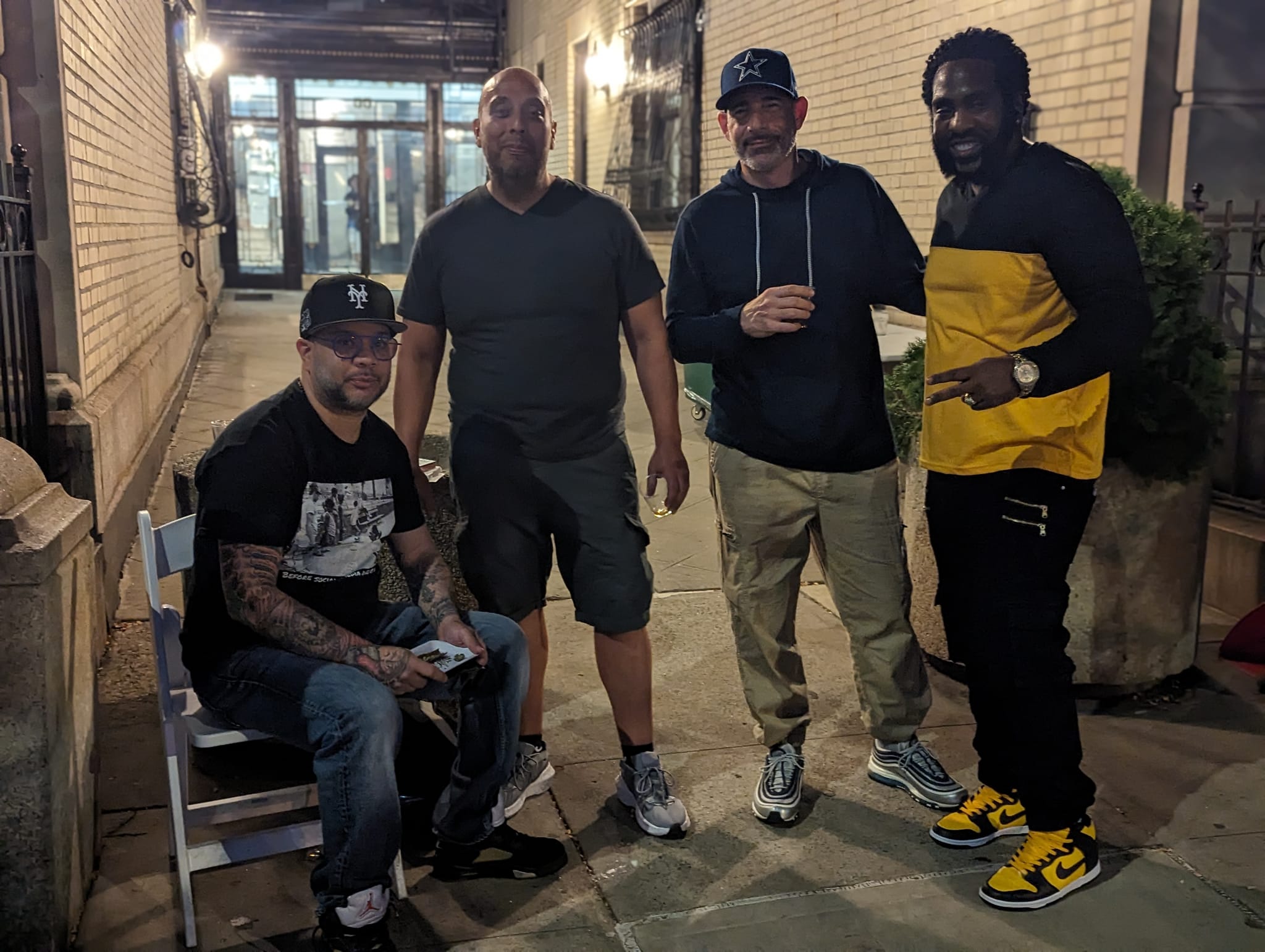
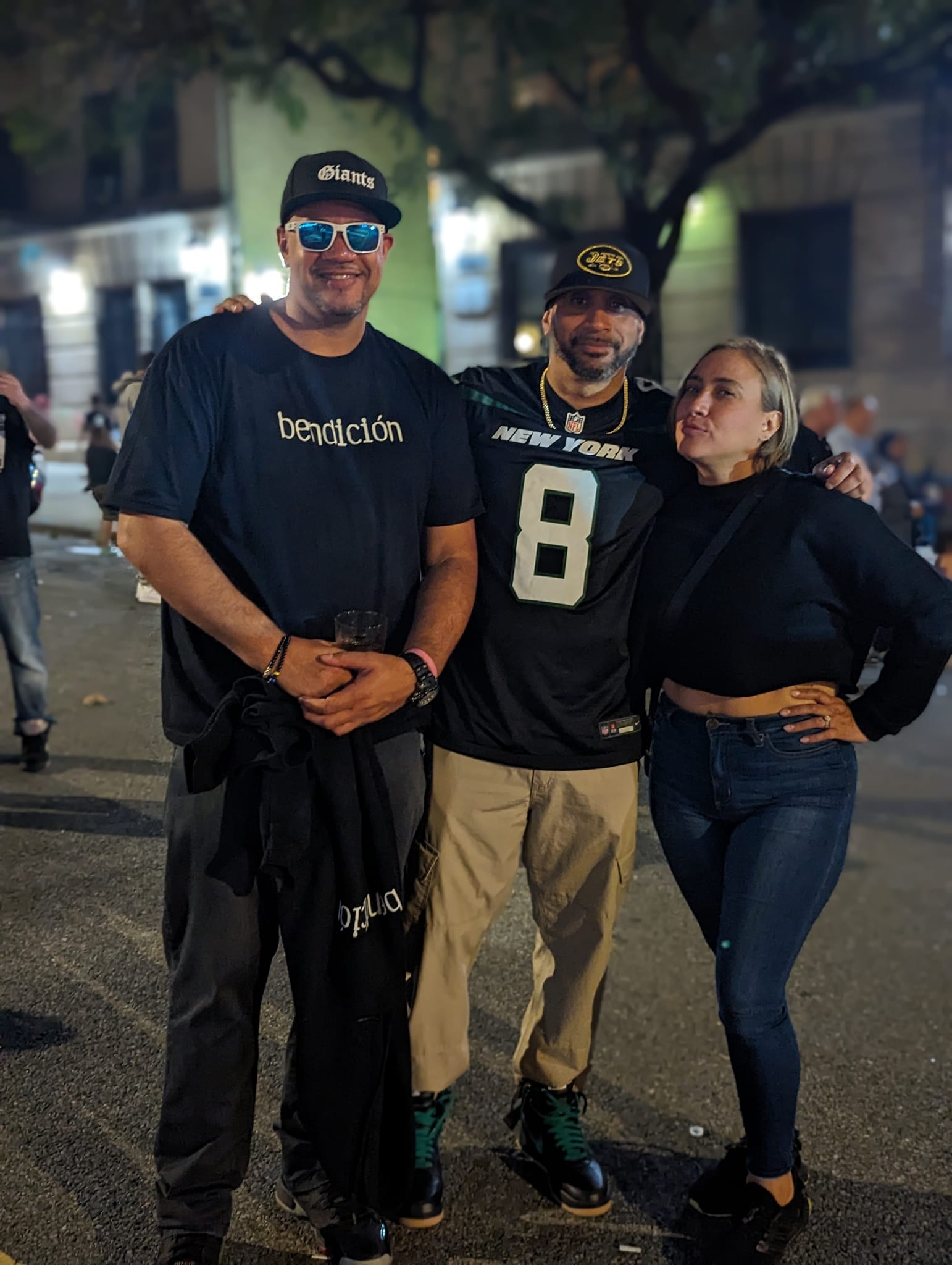
Images of smiling faces sometimes came with soundtracks. You can hear snatches of street-action at Jamie’s Facebook page as well as watch videos with panoramas of the block when it’s sizzling.[2] (I’m reminded Jamie was carrying a water bottle full of Sancerre—hydration is key on Festival day!) Our DJs’ aural feed passed on Mancunian flavor, but their people’s party grooves still beat (what My Weil’s discerning lowbrows would bash as) “Smart City” music. While I haven’t aimed to impinge on Festival mixes for years, I put in a request this time. I went to heaven-on-Tiemann when DJ Cruize played The Heptones’ “Book of Rules” just before Jamie, Councilman Abreu and grassroots messengers took it to the street-stage. Tom taught our whole fam to want that “Book.” I’d lost my younger sister who was with her husband and Maria in the crowd but I bet she was singing along with me as Leroy Sibbles proffered proto-Tommy positivity.
…common people
Like you and me
Are builders for eternity
I’ll allow I teared up as Heptones turned “Bag of Tools” (a plain poem of op-ed-ish uplift, probably taught in Jamaican elementary schools) into reggae fi strivers in the working classes…
Each is given a bag of tools,
A shapeless mass,
A book of rules;
And each must make
Ere life is flown —
A stumbling block
Or a steppingstone.
Tommy helped make Tiemann Place a steppingstone. And neighborhood people stepped up with and for him last Saturday. Jeff Kraus—one the Tenants’ Alliance’s original fantasticoes—has given us his scoop on what happened on “our gorgeous relentless block”:
We and you all were saluted on Saturday with the unveiling of the street sign co-naming Tiemann Place as “Tom DeMott Way”! It was an utterly beautiful day of raucous activity by both children and, well, semi-adults, and fervent reunions of people from our block who haven’t been here for decades (like my Super from the ‘80s). Passionate speeches were given by those who lovingly remember Tom helping them and their neighbors remain in their houses for decades, despite bitter attacks from landlords, speculators and Columbia University who remains the 800-pound gorilla in these parts.
It was just magnificent—a joyous, passionate and righteous celebration of the fact that WE ARE ALL STILL HERE. And the co-naming of our block for Tom, in its official City green metal, means that his legacy will live on forever. Any time someone asks one of us, “What’s that about?”, we can say, “Sit down. I’ll tell you all about it.”
I did some legacy work during the day, handing out a (tweaked) bio of Tom [see here] that our Councilman used to make the case for the co-naming and “A Thousand Years of Curry”—a piece spiced with local knowledge and worldliness that Tom wrote on the verge of the 28th Festival. A young reporter from California—newly enrolled at Columbia Journalism School—picked up on the bio, wondering “what’s a rent strike?” (Who said Cali is the new Kansas?) He followed up after the Festival and I directed him to the Krauses who have the best dope on the early days of the Tenants Alliance. Congressman Espaillat seemed engaged by Tom’s bio too. I think the first graph might’ve grabbed him since it invoked Bob Moses’ example. Espaillat has been one of the sponsors, along with Jamie Raskin, of a bill to posthumously award Moses a Congressional Gold Medal. (Here’s hoping he and Raskin take up Moses’ “National Consensus Project to Eliminate Caste in America’s Classrooms.”) I’ll admit when I saw a photo of the Congressman gazing at the text of the bio, it hit like an uptown match for the famous Magnum image of a solitary suited man staring at a piece of paper he’d found in the detritus after the twin towers collapsed (as if it might hold a clue to what had gone down). That was my bad projection, though. Espaillat may have been flummoxed (slightly) by the hubbub on Tiemann, but he wasn’t in a state of shock. While I’ve got a right to tease my Congressman, I should allow he’s served as a useful vector of cultural transmission. (Try the YouTube video from his virtual Black History Month town hall in 2022 where Bob Moses’ daughter spoke on her father’s Harlem roots.[3])
Intra-Harlem exchange was on the platform at the co-naming ceremony. Reps from East Harlem’s “The Movement for Justice in El Barrio” and the (lamented) Hermanas Maribal Community Center held forth.[4] It was fun when my Spanish-speaking son, taking over from English-only Dad, eased Maribal’s Usmerdys Valenzuela toward the stage.
I managed to have a better conversation with another old comrade of Tom’s from Maribal’s neighborhood. Mario Mazzoni, who lives on Riverside Drive in the 140s, told me how he’d got into photographing the sun coming down on the Hudson, but he was surprised when I talked up the blue hour as the night glided in. He hadn’t realized it’s a thing in the sky over New York City: “So that’s what we get instead of starshine?” Sounds bright to me. (Start spreading the news.) I stayed on this train of thought when I got home, sending Mario Alice Neel’s painting of the Ninth Avenue El—a rail-line that’s gone now but once veered east at 110th St., heading up Frederick Douglass toward the Harlem River.
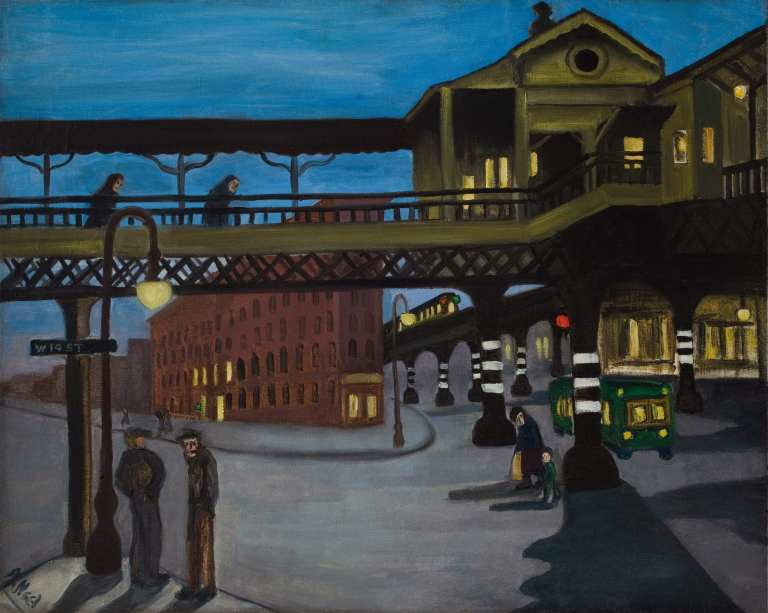
We’ve got our own El at 125th and Broadway and we also get a blue hour worthy of Neel’s. It came through on the night of the day we called Tiemann Tom DeMott Way…
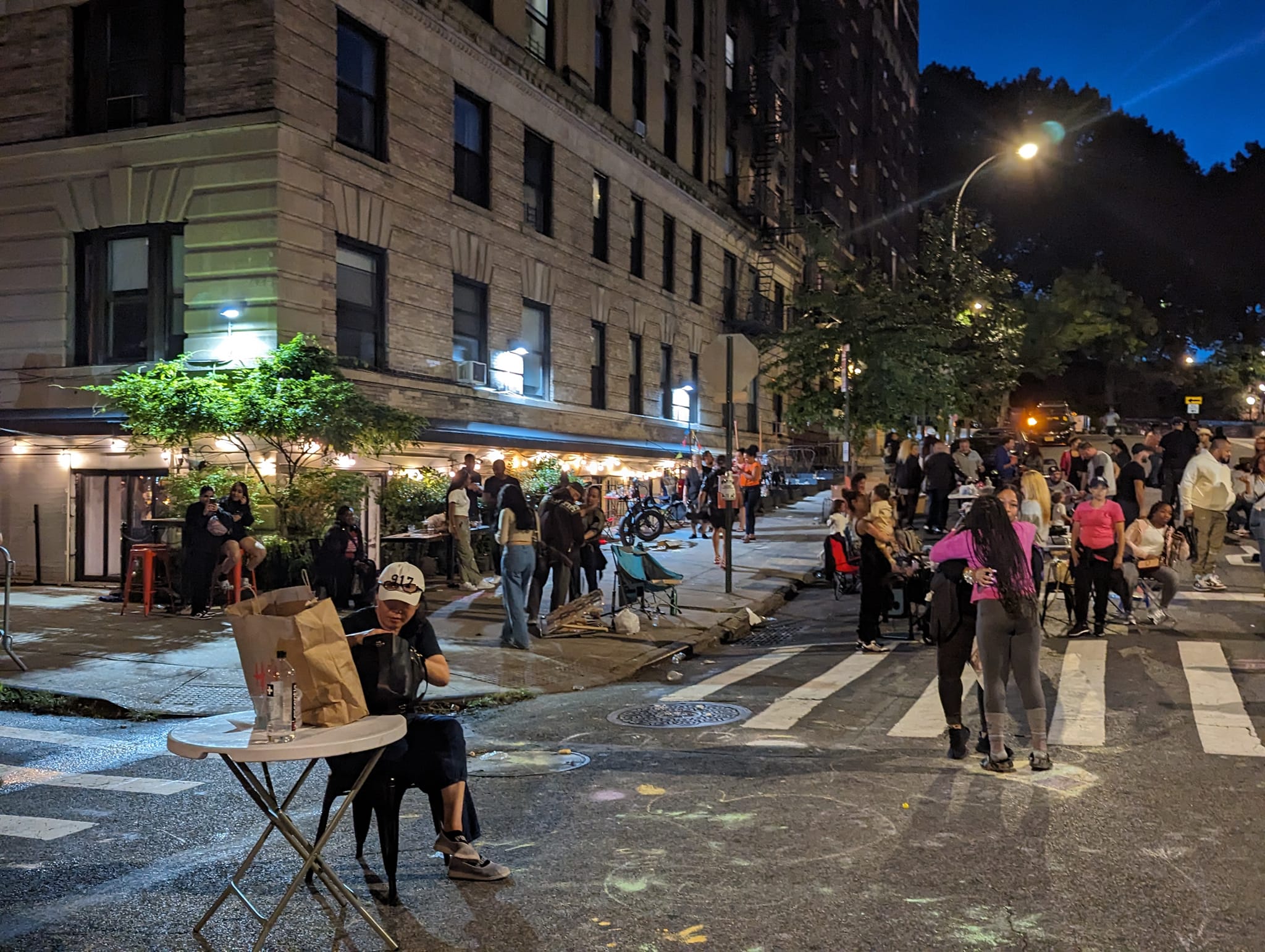
A good time and place to end this after-action report.
..
NOTES
1 Her down low work chimes with wisdom of Martin Glaberman: “Don’t fall for guff about a ‘spontaneous demonstration’—you just don’t know who organized it.”
2 H/T Jessica Amber
2
3 https://www.youtube.com/watch?v=pXli0Ez0cA8&ab_channel=Rep.AdrianoEspaillat
4 Maribal’s Luis Tejada couldn’t attend because he was in D.R. but he emailed his own “mission accomplished” statement: “I am very happy that our brother Tom DeMott will forever be in the place he never left.”